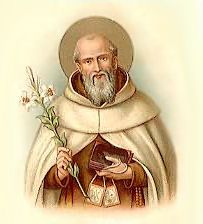OUR LADY OF MT. CARMEL
BEFORE CHRIST
Mount Carmel is a biblical place where the prophet Elijah dwelt. It rises 1,742 feet above sea level and towers above Israel’s Mediterranean coastline. It was here where Elijah prayed to God for the salvation of Israel, which was suffering a terrible drought at the time. He continued to pray and sent his servant up the mountain several times to look for rain. On the seventh try, Elijah’s servant returned with good news. “Behold a little cloud arose out of the sea like a man’s foot” (1 Kings 1:44). Soon thereafter, torrential rains fell upon the parched land and the people of Israel were saved.

Elijah saw the cloud as a symbol of the Virgin mentioned in the prophecies of Isaiah (Isaiah 7:14). The hermits who lived on Mount Carmel followed Elijah’s example and prayed for the advent of the much-awaited Virgin, who would become the mother of the Messiah. The origins of the Carmelite Order can be traced back to Elijah and his hermited disciples.
ST. SIMON STOCK

In the 13th century, during the Crusades, St. Simon Stock joined a group of hermits on Mount Carmel during a pilgrimage to the Holy Land. In 1247, he was elected the 6th superior-general of the Carmelites at the first chapter held in Aylesford, England. However, the order had difficulty gaining general acceptance and suffered much persecution and oppression from secular clergy and other orders which prompted the monks to have recourse to the Blessed Virgin in the year 1251.
On Sunday July 16th, 1251, as Simon Stock knelt in prayer, Our Lady appeared to him, holding the Child Jesus in one arm and the Brown Scapular in the other. She uttered the following words: “Hoc erit tibi et cunctis Carmelitis privilegium, in hoc habitu moriens salvabitur” (This shall be the privilege for you and for all the Carmelites, that anyone dying in this habit shall be saved). On January 13, 1252, the order received a letter of protection from Pope Innocent IV, defending them from harassment.
St. Simon Stock lived a holy life for 100 years and died in the Carmelite monastery at Bordeaux, France on May 16, 1265.
ST. JOHN OF THE CROSS
St. John of the Cross, Spanish San Juan de la Cruz, original name Juan de Yepes y Álvarez, (born June 24, 1542, Fontiveros, Spain—died December 14, 1591, Ubeda; canonized 1726; feast day December 14), one of the greatest Christian mystics and Spanish poets, doctor of the church, reformer of Spanish monasticism, and cofounder of the contemplative order of Discalced Carmelites.
John became a Carmelite monk at Medina del Campo, Spain, in 1563 and was ordained priest in 1567. St. Teresa of Ávila, the celebrated mystic, enlisted his help (1568) in her restoration of Carmelite life to its original observance of austerity. A year later, at Duruelo, he opened the first Discalced Carmelite monastery. Reform, however, caused friction within the order and led to his imprisonment, first in 1576 and again in 1577 at Toledo, where he wrote some of his finest poetry. Escaping in August 1578, he later won high office in the order, becoming vicar provincial of Andalusia from 1585 to 1587. Near the end of his life, the Discalced Carmelites were again troubled by dissension, and he withdrew to absolute solitude.

John schematized the steps of mystical ascent—a self-communion that in quietude leads the individual from the inharmonious distractions of the world to the sublime peace of reunion between the soul and God. John’s schematization combines a poetic sensitivity for the nuances of mystical experience with a theological and philosophical precision guided by his study of St. Thomas Aquinas. By virtue of his intense poems—“Cántico espiritual” (“The Spiritual Canticle”), “Noche oscura del alma” (“The Dark Night of the Soul”), and “Llama de amor viva” (“The Living Flame of Love”)—he achieves preeminence in Spanish mystical literature, expressing the experience of the mystical union between the soul and Christ.
In “Noche oscura,” perhaps his best-known work, he describes the process by which the soul sheds its attachment to everything and eventually passes through a personal experience of Christ’s Crucifixion to his glory. The lyric consists of eight stanzas “in which the soul sings of the fortunate adventure that it had in passing through the dark night of faith…to union with the Beloved.”
Though John reaches peaks of lyricism, he also presents the reader with considerable difficulties because his approach is rigorously intellectual. The same word may recur twice within four lines of a poem with a different symbolism on each occasion.
ST. TERESA OF AVILA

St. Teresa of Ávila, also called Saint Teresa of Jesus, original name Teresa de Cepeda y Ahumada, (born March 28, 1515, Ávila, Spain—died October 4, 1582, Alba de Tormes; canonized 1622; feast day October 15), Spanish nun, one of the great mystics and religious women of the Roman Catholic Church, and author of spiritual classics. She was the originator of the Carmelite Reform, which restored and emphasized the austerity and contemplative character of primitive Carmelite life. St. Teresa was elevated to doctor of the church in 1970 by Pope Paul VI, the first woman to be so honoured.
Her mother died in 1529, and, despite her father’s opposition, Teresa entered, probably in 1535, the Carmelite Convent of the Incarnation at Ávila. Within two years her health collapsed, and she was an invalid for three years, during which time she developed a love for mental prayer. After her recovery, however, she stopped praying. She continued for 15 years in a state divided between a worldly and a divine spirit, until, in 1555, she underwent a religious awakening.
In 1558 Teresa began to consider the restoration of Carmelite life to its original observance of austerity, which had relaxed in the 14th and 15th centuries. Her reform required utter withdrawal so that the nuns could meditate on divine law and, through a prayerful life of penance, exercise what she termed “our vocation of reparation” for the sins of humankind. In 1562, with Pope Pius IV’s authorization, she opened the first convent (St. Joseph’s) of the Carmelite Reform. A storm of hostility came from municipal and religious personages, especially because the convent existed without endowment, but she staunchly insisted on poverty and subsistence only through public alms.
John Baptist Rossi, the Carmelite prior general from Rome, went to Ávila in 1567 and approved the reform, directing Teresa to found more convents and to establish monasteries. In the same year, while at Medina del Campo, Spain, she met a young Carmelite priest, Juan de Yepes (later St. John of the Cross, the poet and mystic), who she realized could initiate the Carmelite Reform for men. A year later Juan opened the first monastery of the Primitive Rule at Duruelo, Spain.
Despite frail health and great difficulties, Teresa spent the rest of her life establishing and nurturing 16 more convents throughout Spain. In 1575, while she was at the Sevilla (Seville) convent, a jurisdictional dispute erupted between the friars of the restored Primitive Rule, known as the Discalced (or “Unshod”) Carmelites, and the observants of the Mitigated Rule, the Calced (or “Shod”) Carmelites. Although she had foreseen the trouble and endeavoured to prevent it, her attempts failed. The Carmelite general, to whom she had been misrepresented, ordered her to retire to a convent in Castile and to cease founding additional convents; Juan was subsequently imprisoned at Toledo in 1577.
In 1579, largely through the efforts of King Philip II of Spain, who knew and admired Teresa, a solution was effected whereby the Carmelites of the Primitive Rule were given independent jurisdiction, confirmed in 1580 by a rescript of Pope Gregory XIII. Teresa, broken in health, was then directed to resume the reform. In journeys that covered hundreds of miles, she made exhausting missions and was fatally stricken en route to Ávila from Burgos.
Teresa’s ascetic doctrine has been accepted as the classical exposition of the contemplative life, and her spiritual writings are among the most widely read. Her Life of the Mother Teresa of Jesus (1611) is autobiographical; the Book of the Foundations (1610) describes the establishment of her convents. Her writings on the progress of the Christian soul toward God are recognized masterpieces: The Way of Perfection (1583), The Interior Castle (1588), Spiritual Relations, Exclamations of the Soul to God (1588), and Conceptions on the Love of God. Of her poems, 31 are extant; of her letters, 458.
ST. THERESE OF THE CHILD JESUS
St. Thérèse of Lisieux, also called St. Teresa of the Child Jesus or the Little Flower, original name Marie-Françoise-Thérèse Martin, (born January 2, 1873, Alençon, France—died September 30, 1897, Lisieux; canonized May 17, 1925; feast day October 1), Carmelite nun whose service to her Roman Catholic order, although outwardly unremarkable, was later recognized for its exemplary spiritual accomplishments. She was named a doctor of the church by Pope John Paul II in 1997.

Thérèse was the youngest of nine children, five of whom survived childhood. After her mother died of breast cancer in 1877, Thérèse moved with her family to Lisieux. In the deeply religious atmosphere of her home, her piety developed early and intensively. All four of her elder sisters became nuns, and at the age of 15 she entered the Carmelite convent at Lisieux, having been refused admission a year earlier. Although she suffered from depression, scruples—a causeless feeling of guilt—and, at the end, religious doubts, she kept the rule to perfection and maintained a smiling, pleasant, and unselfish manner. Before her death from tuberculosis, she acknowledged that, because of her difficult nature, not one day had ever passed without a struggle. Her burial site at Lisieux became a place of pilgrimage, and a basilica bearing her name was built there (1929–54).
